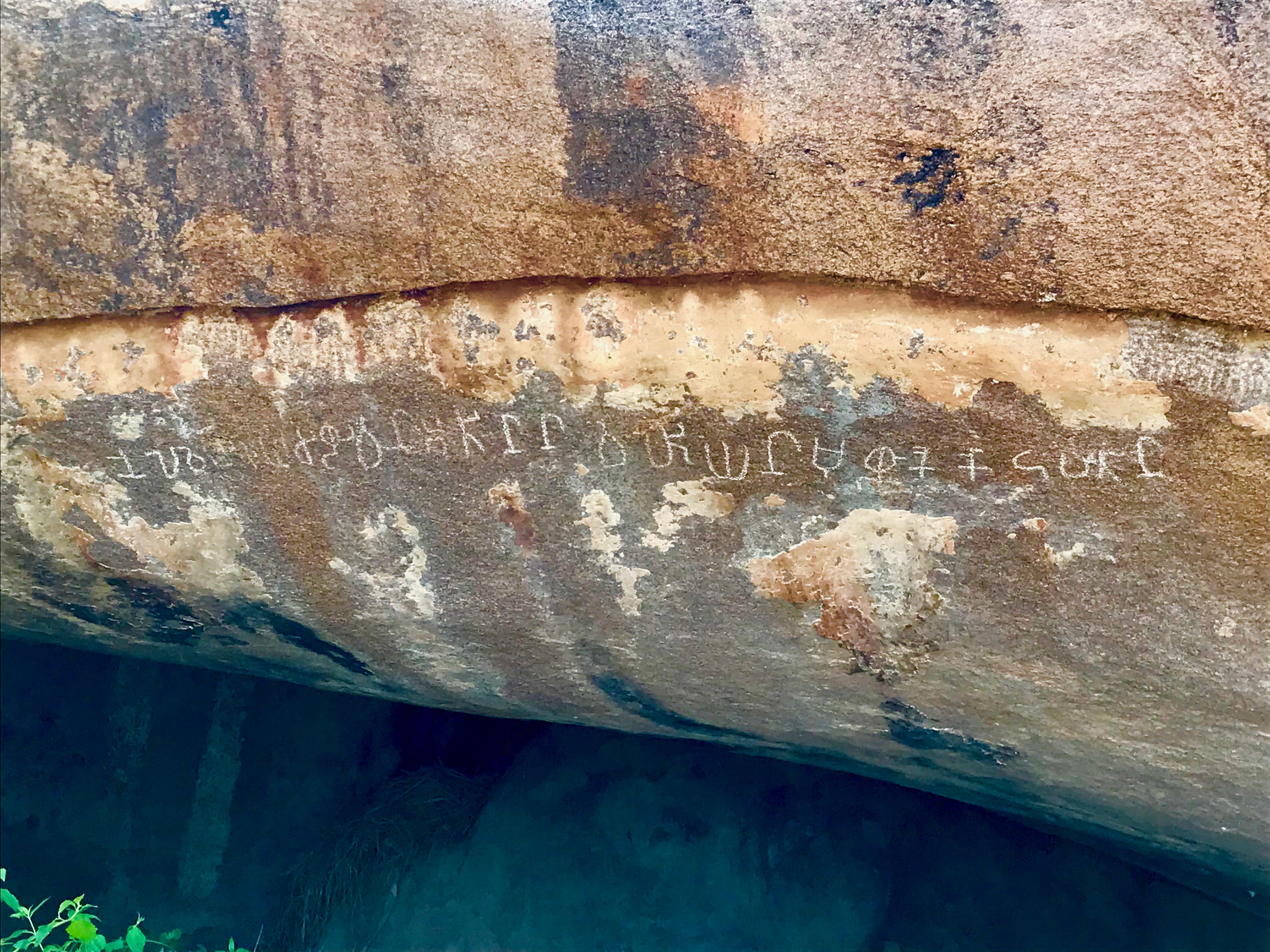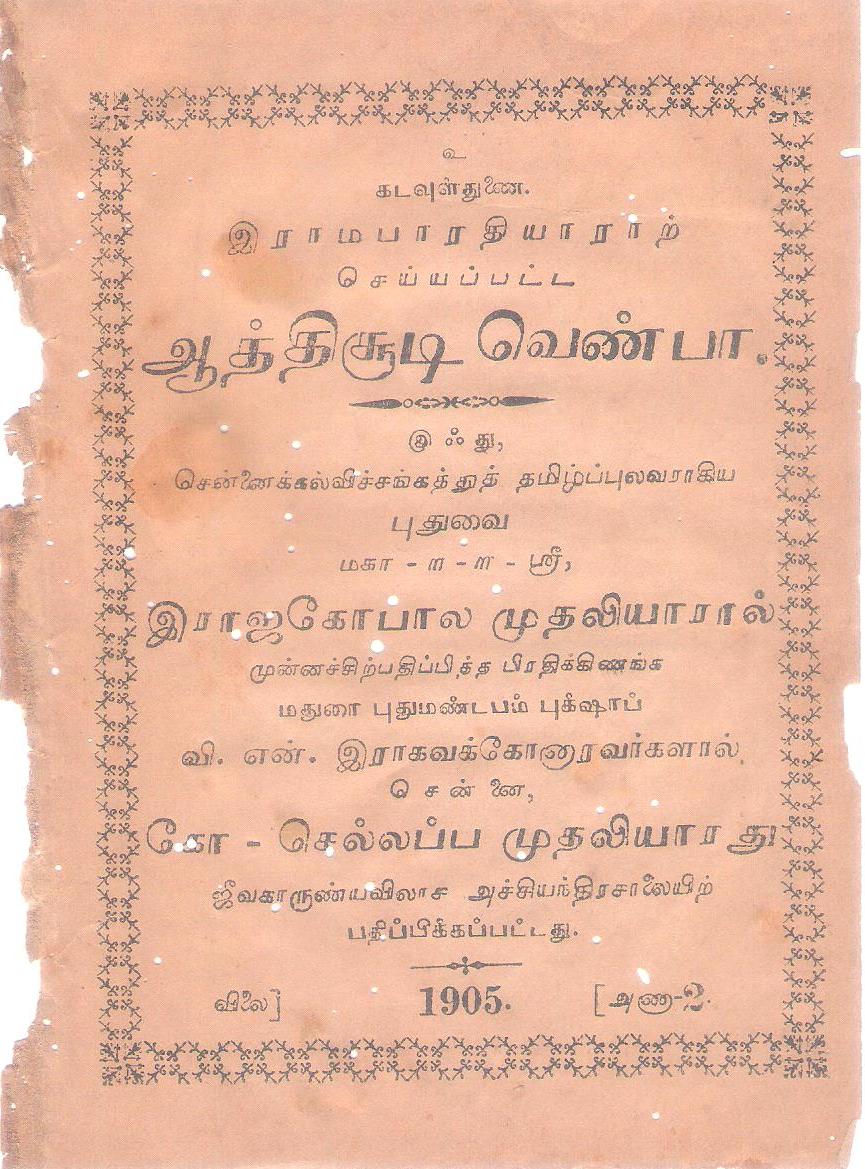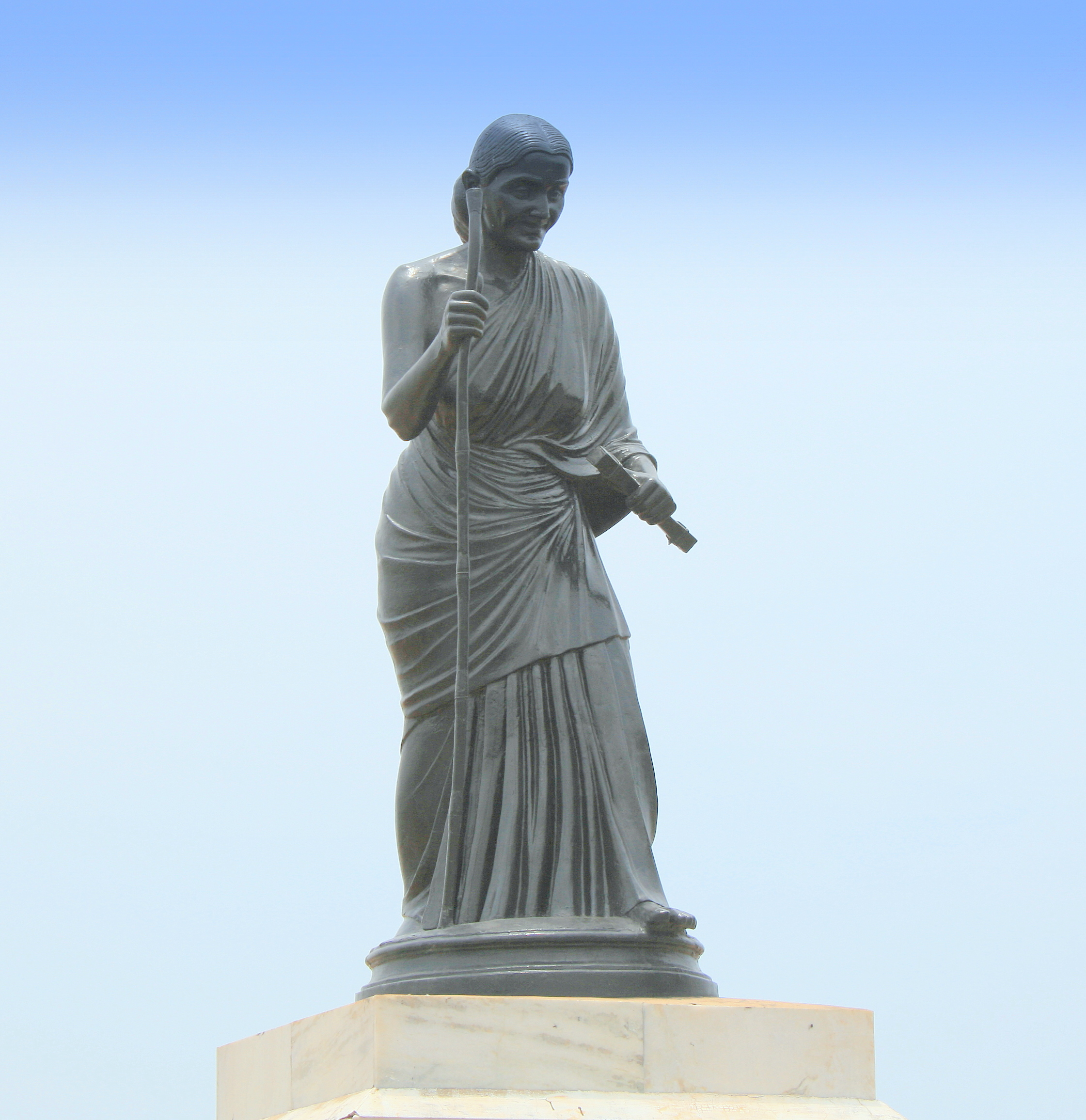|
Tiruvalluva Maalai
Tiruvalluva Maalai (Tamil: திருவள்ளுவ மாலை), literally 'Garland of Valluvar', is an anthology of ancient Tamil paeans containing fifty-five verses each attributed to different poets praising the ancient work of the Kural and its author Valluvar. With the poets' time spanning across centuries starting from around 1st century CE, the collection is believed to have reached its present form by 10th century CE. With the historical details of the ancient philosopher and his work remaining obscure, much of the legend on the Kural and Valluvar as they are known today are chiefly from this work. The collection also reveals the name of the author of the Kural text as 'Valluvar' for the first time, as Valluvar himself composed the Kural text centuries earlier without indicating his name anywhere in his work. Reminiscing this, E. S. Ariel, a French scholar of the 19th century, famously said of the Tirukkural thus: ''Ce livre sans nom, par un autre sans nom'' (" ... [...More Info...] [...Related Items...] OR: [Wikipedia] [Google] [Baidu] |
Tamil Language
Tamil (; ' , ) is a Dravidian language natively spoken by the Tamil people of South Asia. Tamil is an official language of the Indian state of Tamil Nadu, the sovereign nations of Sri Lanka and Singapore, and the Indian territory of Puducherry (union territory), Puducherry. Tamil is also spoken by significant minorities in the four other South Indian states of Kerala, Karnataka, Andhra Pradesh and Telangana, and the Union Territory of the Andaman and Nicobar Islands. It is also spoken by the Tamil diaspora found in many countries, including Malaysian Tamil, Malaysia, Myanmar Tamils, Myanmar, Tamil South Africans, South Africa, British Tamils, United Kingdom, Tamil Americans, United States, Tamil Canadians, Canada, Tamil Australians, Australia and Tamil Mauritians, Mauritius. Tamil is also natively spoken by Sri Lankan Moors. One of 22 scheduled languages in the Constitution of India, Tamil was the first to be classified as a Languages of India, classical language of India ... [...More Info...] [...Related Items...] OR: [Wikipedia] [Google] [Baidu] |
Old Tamil Language
Old Tamil is the period of the Tamil language spanning from 300 BCE to 700 CE. Prior to Old Tamil, the period of Tamil linguistic development is termed as Pre Tamil. After the Old Tamil period, Tamil becomes Middle Tamil. The earliest records in Old Tamil are inscriptions from between the 3rd and 1st century BCE in caves and on pottery. These inscriptions are written in a variant of the Brahmi script called Tamil Brahmi. The earliest long text in Old Tamil is the '' Tolkāppiyam'', an early work on Tamil grammar and poetics, whose oldest layers could be as old as the mid 2nd century BCE.Zvelebil, K. ''The Smile of Murugan: On Tamil Literature of South '' p.XX Old Tamil preserved many features of Proto-Dravidian, the earliest reconstructed form of the Dravidian including inventory of consonants, the syllable structure, and various grammatical features. History According to Bhadriraju Krishnamurti, Tamil, as a Dravidian language, descends from Proto-Dravidian, a proto-lang ... [...More Info...] [...Related Items...] OR: [Wikipedia] [Google] [Baidu] |
Saraswathi
Saraswati ( sa, सरस्वती, ) is the Hindu goddess of knowledge, music, art, speech, wisdom, and learning. She is one of the Tridevi, along with the goddesses Lakshmi and Parvati. The earliest known mention of Saraswati as a goddess is in the Rigveda. She has remained significant as a goddess from the Vedic period through the modern period of Hindu traditions. She is generally shown to have four arms, holding a book, a rosary, a water pot, and a musical instrument called the veena. Each of these items have a symbolic meaning in Hinduism. Some Hindus celebrate the festival of Vasant Panchami (the fifth day of spring, and also known as Saraswati Puja and Saraswati Jayanti in many regions of India) in her honour, and mark the day by helping young children learn how to write the letters of the alphabet on that day. The goddess is also revered by believers of the Jain religion of west and central India, as well as some Buddhist sects. Etymology Saraswati, is a San ... [...More Info...] [...Related Items...] OR: [Wikipedia] [Google] [Baidu] |
Kapilar
Kapilar or Kabilar (Tamil: கபிலர்) was the most prolific Tamil poet of the Sangam period (c. 3rd century BCE to 3rd century CE). He alone contributed some 206 poems, or a little less than 10% of the entire Sangam-era classical corpus by 473 ancient poets. Held in high regard by other poets of the Sangam era, as well as the post-Sangam era, he is variously dated to have lived between c. 50–125 CE, or 140–200 CE. He was a contemporary of Karikala Chola, Irunkōvēl and Vēl Pāri. He was the close friend, confidant and alleged favorite of Vēl Pāri, one of the Vēlir kings.''Studies in Tamil Literature and History by Ramachandra Dikshitar'', pages 55-59 He was the author of Inna Narpathu, a didactic work of the Sangam literature. Verse 5 of the Tiruvalluva Maalai is also attributed to him. Early life Kapilar was born in Thiruvadhavur in the Pandyan Kingdom. Initially a poet at the Pandyan court, he left Madurai at an early age to travel across various kingdoms ... [...More Info...] [...Related Items...] OR: [Wikipedia] [Google] [Baidu] |
Quatrain
A quatrain is a type of stanza, or a complete poem, consisting of four lines. Existing in a variety of forms, the quatrain appears in poems from the poetic traditions of various ancient civilizations including Persia, Ancient India, Ancient Greece, Ancient Rome, and China, and continues into the 21st century, where it is seen in works published in many languages. This form of poetry has been continually popular in Iran since the medieval period, as Ruba'is form; an important faction of the vast repertoire of Persian poetry, with famous poets such as Omar Khayyam and Mahsati Ganjavi of Seljuk Persia writing poetry only in this format. Michel de Nostredame ( Nostradamus) used the quatrain form to deliver his famous prophecies in the 16th century. There are fifteen possible rhyme schemes, but the most traditional and common are ABAA, AAAA, ABAB, and ABBA. Forms *The heroic stanza or elegiac stanza consists of the iambic pentameter, with the rhyme scheme of ABAB or ... [...More Info...] [...Related Items...] OR: [Wikipedia] [Google] [Baidu] |
Venpa
Venpa or Venba ('' வெண்பா'' in Tamil) is a form of classical Tamil poetry. Classical Tamil poetry has been classified based upon the rules of metric prosody. Such rules form a context-free grammar. Every venba consists of between two and twelve lines. The venpa meter is used in songs of the types neṭu veṇ pāṭṭu ('long song in venpa meter'), kuṟu veṇ pāṭṭu 'short song in venpa meter', kaikkiḷai "one-sided love," and paripāṭṭu 'song that is quite accommodative' and in satirical compositions (aṅkatac ceyyuḷ). Popular books written in venba style # All 1330 couplets from the Thirukkural, composed by Thiruvalluvar, are examples of venba. Tirukkural comes under a sub-category of venba called Kural venba, wherein each kural or couplet has only two lines. # Nala venba 1 is another classical work written in venba style. # Niti venba 2 is another venba style book that preaches values. # Acharakkovai 3 is another venba style book that preaches ... [...More Info...] [...Related Items...] OR: [Wikipedia] [Google] [Baidu] |
Couplet
A couplet is a pair of successive lines of metre in poetry. A couplet usually consists of two successive lines that rhyme and have the same metre. A couplet may be formal (closed) or run-on (open). In a formal (or closed) couplet, each of the two lines is end-stopped, implying that there is a grammatical pause at the end of a line of verse. In a run-on (or open) couplet, the meaning of the first line continues to the second. Background The word "couplet" comes from the French word meaning "two pieces of iron riveted or hinged together". The term "couplet" was first used to describe successive lines of verse in Sir P. Sidney's '' Arcadia '' in 1590: "In singing some short coplets, whereto the one halfe beginning, the other halfe should answere." While couplets traditionally rhyme, not all do. Poems may use white space to mark out couplets if they do not rhyme. Couplets in iambic pentameter are called '' heroic couplets''. John Dryden in the 17th century and Alexander Pope i ... [...More Info...] [...Related Items...] OR: [Wikipedia] [Google] [Baidu] |
Metre (poetry)
In poetry, metre ( Commonwealth spelling) or meter ( American spelling; see spelling differences) is the basic rhythmic structure of a verse or lines in verse. Many traditional verse forms prescribe a specific verse metre, or a certain set of metres alternating in a particular order. The study and the actual use of metres and forms of versification are both known as prosody. (Within linguistics, " prosody" is used in a more general sense that includes not only poetic metre but also the rhythmic aspects of prose, whether formal or informal, that vary from language to language, and sometimes between poetic traditions.) Characteristics An assortment of features can be identified when classifying poetry and its metre. Qualitative versus quantitative metre The metre of most poetry of the Western world and elsewhere is based on patterns of syllables of particular types. The familiar type of metre in English-language poetry is called qualitative metre, with stressed syllables com ... [...More Info...] [...Related Items...] OR: [Wikipedia] [Google] [Baidu] |
Kural (poetic Form)
The Kural is one of the most important forms of classical Tamil language poetry. It is a very short poetic form being an independent couplet complete in 2 lines, the first line consisting of 4 words and the second line consisting of 3. As one of the five types of Venpa stanza, it must also conform to the grammar for Venpa, the most difficult and the most highly esteemed of stanzaic structures in classical Tamil literature. The ''Tirukkuṛaḷ'' by Tiruvalluvar, one of the greatest philosophical works in Tamil, is a typical example. Structure Prosodic background The Tamil conception of metrical structure includes elements that appear in no other major prosodic system. This discussion is presented in terms of syllables, feet, and lines (although syllables are not explicitly present in Tamil prosodic theory). Similarly to classical Latin, Greek, and Sanskrit prosody, a syllable is long if its vowel is (1) long (including diphthongs) or (2) followed by two or more consonants. Ge ... [...More Info...] [...Related Items...] OR: [Wikipedia] [Google] [Baidu] |
Avvaiyar
Avvaiyar ( Tamil: ஔவையார்) was the title of more than one female poet who were active during different periods of Tamil literature. They were some of the most famous and important female poets of the Tamil canon. Abidhana Chintamani states that there were three female poets titled ''Avvaiyar''. Among them, the first Avvaiyar lived during the Sangam period (c. 3rd century BCE) and is said to have had cordial relations with the Tamil chieftains Vēl Pāri and Athiyamān. She wrote 59 poems in the Puṟanāṉūṟu. Avvaiyar II lived during the period of Kambar and Ottakoothar during the reign of the Chola dynasty in the tenth century. She is often imagined as an old and intelligent lady by Tamil people. Many poems and the Avvai Kural, comprising 310 kurals in 31 chapters, belong to this period. The third Avvaiyar is the most widely known for her ' Vinayagar Agaval', ' Aathichoodi', ' Kondrai Vendhan', ' Nalvazhi' and ' Moodhurai'. Name etymology The name Av ... [...More Info...] [...Related Items...] OR: [Wikipedia] [Google] [Baidu] |
Tamil Sangam
The Tamil Sangams (Tamil: சங்கம் ''caṅkam'', Old Tamil 𑀘𑀗𑁆𑀓𑀫𑁆, from Sanskrit ''saṅgha'') were assemblies of Tamil scholars and poets that, according to traditional Tamil accounts, occurred in the remote past. Scholars believe that these assemblies were originally known as ''kooṭam'' or "gathering," which was also a name for Madurai. Three assemblies are described. The legend has it that the first two were held in cities since "taken by the sea", and the third was held in the present-day city of Madurai. The Sangam period extended from roughly 200 BCE to 200 CE (early Chola period before the interregnum), when the earliest extant works of Tamil literature were written (also known as Sangam literature).Kamil Veith Zvelebil, ''Companion Studies to the History of Tamil Literature'', pp12See K.A. Nilakanta Sastry, ''A History of South India,'' OUP (1955) pp 105 However, the name ''Sangam'' and the associated legends probably derive from a much la ... [...More Info...] [...Related Items...] OR: [Wikipedia] [Google] [Baidu] |
Manakkudavar
Manakkudavar (c. 10th century CE) was a Tamil scholar and commentator known for his commentary on the Tirukkural. His is the earliest of the available commentaries on the Kural text, and hence considered to bear closest semblance with the original work by Valluvar. He was among the canon of Ten Medieval Commentators of the Kural text most highly esteemed by scholars. He was among the five ancient commentators whose commentaries had been preserved and made available to the Modern era, the others being Pari Perumal, Kaalingar, Paridhi, and Parimelalhagar. The commentary of Manakkudavar remains the second most popular commentary on the Kural text, next only to that of Parimelalhagar. Early life Little is known about Manakkudavar in comparison with other medieval commentators. This is partly due to lack of any introductory texts in his commentary. There is no information about his parents either. Manakkudavar is believed to have been born in Manakkudi, from which he came to be ref ... [...More Info...] [...Related Items...] OR: [Wikipedia] [Google] [Baidu] |



.jpg)



